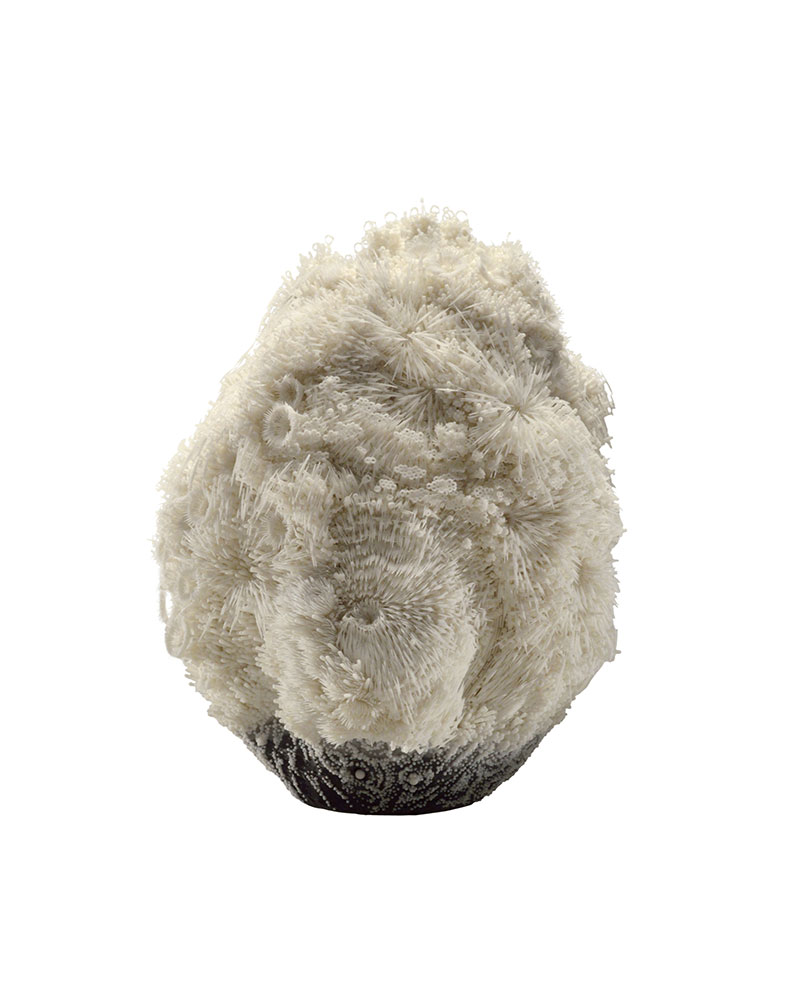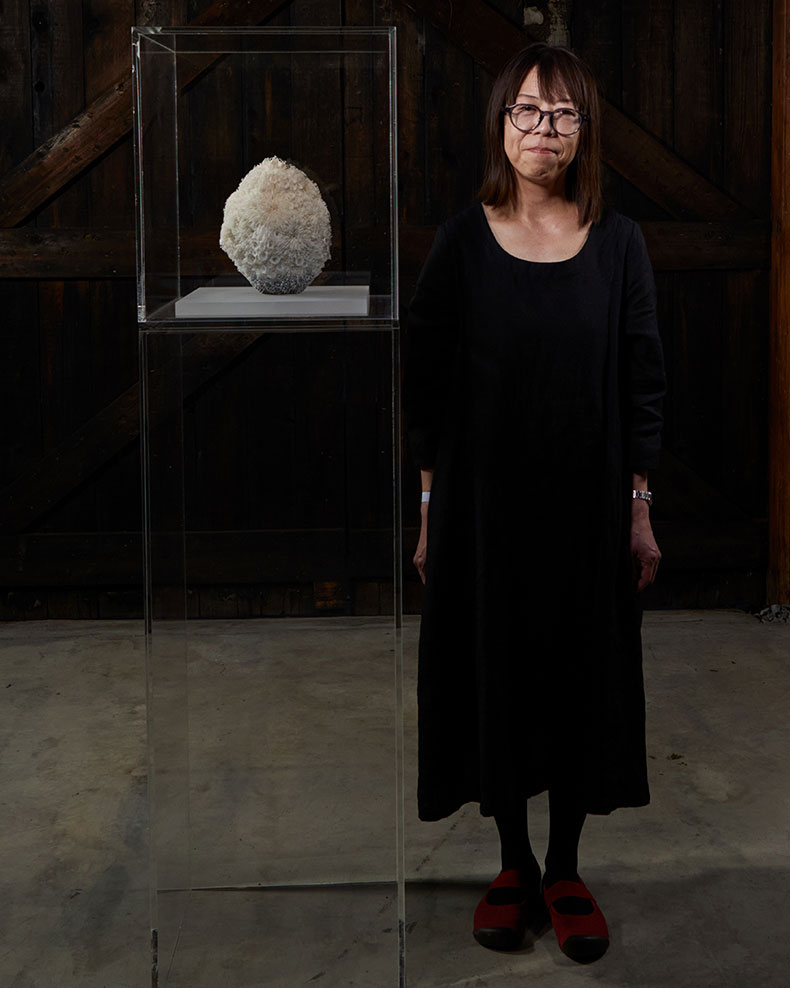Last month, the Japanese ceramicist Eriko Inazaki was announced the winner of the 2023 Loewe Foundation Craft Prize for ‘Metanoia’ (2019). The work, like many of Inazaki’s pieces, was created through a painstaking process of layering hundreds of minuscule ceramic pieces on to a clay centre before firing the delicate composition in the kiln. ‘Metanoia’ is on show along with works by the other 30 finalists at Isamu Noguchi’s Studio in New York until 18 June.
Where do you work?
My studio is located in Kagawa in the Shikoku region of Japan. Kagawa is the smallest prefecture in Japan, separate from the mainland. It is a tranquil area surrounded by mountains and sea. My studio is in the suburbs, not far from the city. The area is not known for pottery, but I took a liking to the peaceful environment and have been based here for almost 20 years.
In Takamatsu city, where I live, there is a town called Mure. This is where you can find the Isamu Noguchi Garden Museum, that preserves the home and atelier where Noguchi spent the last 20 years of his life. I often visit the museum for its beautiful garden so I was pleasantly surprised to learn that the Loewe Craft Prize exhibition was going to be hosted at the Noguchi Museum in New York.
There is a granite material that can only be found in Mure, called aji stone. It is said that Noguchi was fascinated by it. And as for traditional crafts, lacquerware is deeply rooted in the area – so much so that it has its own genre called ‘Kagawa lacquerware’. Japan is a country where ceramics are very popular, and there are countless areas that produce wonderful pottery. By keeping a distance from such places, I feel that I am able to create works with a unique sensitivity and approach.
Metanoia (2019), Eriko Inazaki. Photo: courtesy Loewe

How would you describe the atmosphere of your studio?
My studio is in old Japanese style: a single-storey row house, made of wood. It is a place surrounded by rice fields, where you can enjoy the beautiful scenery of each season.
It consists of two spaces. The electric kiln is placed in a separate room with bare earthen flooring. It has wooden framed windows with thin glass panes, clay walls that have turned cream-coloured over time and bamboo screens to shade the sun. My workbenches and chairs were all given to me by friends and my shelves are made from scrap wood.
Do you follow a routine when you’re in the studio?
I don’t have a particular routine that I follow in my day-to-day life. Some days it takes me longer to concentrate; on other days I have no issues. I find it very challenging to control this. I do my best to concentrate, to create strict deadlines and abide by them, but it rarely goes as planned!
My artistic process changed drastically with the pandemic. We were encouraged to stay at home and restricted from going out or eating out. I found the situation depressing, but at the same time, it gave me a reason to stay in for long periods. I was able to immerse myself into my work and I experimented with new techniques that I had never tried before. After a very long period of practice, I was able to bring them to fruition.
Eriko Inazaki standing next to her prize-winning artwork Metanoia (2019). Photo: courtesy Loewe

Is there anything that frustrates you about your space?
My studio is very old and small so there are many aspects that I would improve, but so far, I am not frustrated enough to leave. I concentrate on making one piece at a time: I never work on multiple projects simultaneously. This is because my passion towards each project weakens when I’m tackling multiple pieces, so instead I work on the same project in the same place throughout the year. As this requires long hours of sitting and hurts my back and hip, I am currently looking for a more suitable chair!
Do you work alone?
Yes, I work alone. I once participated in an artist-in-residence program hosted at the Shigaraki Ceramic Cultural Park in Koka for half a year, where I lived and worked with people from all over the world. It was a very inspiring experience. I discovered different approaches taken towards ceramic materials, which broadened my perspective. I’d like to participate in other programmes if I have the opportunity.
Do you listen to music while you work?
When I’m working, I usually have a film or a TV series playing in the background. As I am focused on my work, I am not watching but rather listening. I feel that classic movies and TV shows that teach life lessons make the best listening material while working. I often listen to Hayao Miyazaki’s animation films, as the music and the characters’ dialogue are beautiful.
What’s the strangest object in your studio?
There is nothing especially strange in my studio, but there are various types of stones laying around the space. I am very fond of minerals, so there are beautiful crystalline minerals and stones that I’ve picked up on the beach or by the side of the road. As a personal project, I sometimes try coating muddy clay onto beehives and insect shells then firing them. I enjoy this process as it is different from my professional projects; each time it feels like I’m adding a new specimen to a collection, and there is always something to learn from nature.
Who is the most interesting visitor you’ve ever had to the studio?
I work in a completely private space, so no one visits the studio. I regard the studio as a very personal place! As I work alone for long periods of time, over the years I have found myself becoming more and more interested in the intricate and delicate layers of small forms that can only be noticed up close. Perhaps it is the solitude that gives me the power to create a unique worldview. In a sense, my studio is like my own personal laboratory.
Is anything (or anyone) banned?
There was a horrifying incident in the past when a small bird entered through the cracks in the building and almost damaged my artwork. A snake has also entered through a hole. I fix the hole each time an incident occurs. The animals are not to blame, but they are banned from entering my studio.
The Loewe Foundation Craft Prize 2023 exhibition is at Isamu Noguchi’s Studio in New York until 18 June.



